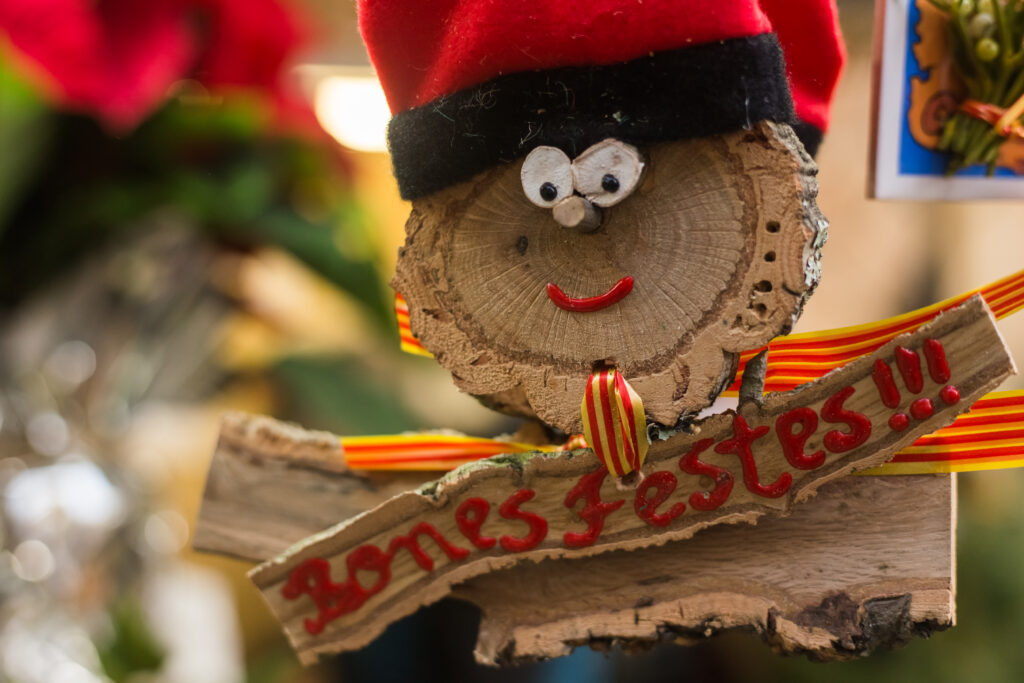We’re only days away from everyone’s favorite Christmas and New Year holidays and not only small children but also adults throughout the world are excited about upcoming miracle and, of course, gifts!
And if the smallest residents of Great Britain are always waiting Father Christmas in these days, then Spanish children can boast of a whole galaxy of magical characters who are in a hurry to visit them during the winter holidays to bring best candy and gifts. Amusing that almost every region of Spain has its own special fairy character with its own special traditions.
First, let’s start with those who give their gifts to kids throughout Spain and bear well-known names. These include Papa Noel (Spain) or Father Christmas (England), or Santa Claus (USA and Canada), or Père Noël (France) as well as Los Reyes Magos (The Three Wise Men).
According to the annual custom of the legendary character Papa Noel, on the night of December 24-25, he makes his way through the chimneys of houses and leaves presents under the Christmas tree.
The visit of Their Majesties the Kings of the East (Los Reyes Magos) takes place at dawn from January 5 to 6 and that is based on the figure of the three wise men mentioned in the Bible – Gaspar (or Caspar), Melchior, and Balthasar – all they honored the birth of a son of God with generous gifts (gold, frankincense and myrrh). In the XIX century, this date became a children’s beloved holiday in Spain and they began to receive magic presents on this magic night of kings.
What is the Difference Between Winter Holidays with Papa Noel and Los Reyes Magos?

As for the first character, its appearance dates back to pagan traditions, not related to any religion. On the other hand, meeting him coincides with the beginning of the Christmas holidays for kids, so they have more time to enjoy their gifts.
In Spain, as in almost all of Europe, Christmas Eve is a more family-friendly holiday, where the greater part of the family gathers, and holy and magic atmosphere lets to share this joy all together.
The Three Wise Men day’s celebration date has also its advantages. First of all, it is associated with the cultural traditions of Spain itself and is carried out on a large scale. On this day, a solemn cavalcade of the Three Kings takes place – an unusually bright and bewitching spectacle. This event is aimed at the little ones when Christmas Eve, Christmas and New Year are already left behind. It is the perfect end to the Christmas celebrations that bring the whole family together again.
What is the Difference Between the Characters of Papa Noel and Los Reyes Magos?
In fact, there are not many differences between Papa Noel and Los Reyes Magos or Father Christmas and the Magi, except for the origin of each legend. The Magi have biblical and Christian traditions that go hand in hand with the religious meaning of Christmas and Epiphany and Papa Noel or Father Christmas or Santa Claus has more to do with the secular aspects of these holidays.
The Papa Noel character has its origins in Dutch legend under the name Sinterklass, a variant of the name of St. Nicholas. The idea of this holiday was brought by Dutch settlers to New Amsterdam (New York) in the XVII century. And already in 1823, Clement Clarke Moore wrote his famous poem « A Visit from St. Nicholas», in which almost our present-day Papa Noel appears, merrily flying across the sky on a sleigh pulled by reindeer. An interesting fact: at first this good-natured old man was dressed in green clothes, until in 1931 the Coca-Cola company dressed up him in red and white, as Santa Claus (and all his other names including Papa Noel) is known today all over the world.
The Magi, in turn, are of Christian origin, and information about them provided by the Gospel of St. Matthew and the Apocryphal Gospels, where much is said about their visit, personality and origin. The legend states that three wise men followed the star of Bethlehem, which led them to the newborn son of God, whom they hurried to shower with their best gifts.
And if the cavalcade of three kings and various figurines of Papa Noel can be found in Spain everywhere, then the local magic characters of the Spanish regions are less familiar to the general public, and therefore we would tell you more about them right now.
Catalonia – Tió de Nadal or Caga Tió

Big Christmas markets in Barcelona usually offer a lot of funny logs on two legs with a cute face and a Catalan headdress. Meet this Catalan Christmas hero – Caga Tió or Fer Cagar el Tió or Tió de Nadal. And this is not a simply log, but a magical one that pleases local children with gifts along with Papa Noel and Los Reyes Magos. But it specializes more in sweet gifts that he has to «poop» during the magic winter holidays, because his name literally translates as «pooping uncle”.
Who is this Caga Tió and what is its origin? In the days before the winter solstice (originally that was a pagan tradition that eventually passed into the Christmas holidays), the smallest inhabitants brought a funny log to their home to feed and care for: the better you feed it, the more generous it will be!
Usually the kids would feed them what was left on their own plates – a good reason to share something! What Tio didn’t eat was taken away by their parents, quietly and discreetly. Initially, on Christmas Eve, after dinner, the family stood around Caga Tio and he was hit with a cane singing special christmas songs. From under the blanket, Tio «pooped» small gifts (usually candy, waffles, nougat, etc.), which ensured «sweet holidays» for the children.
During the Christmas holidays, there is sure to be own Tio de Nadal in every Catalan home. The tradition of using a log as a festive symbol arose in ancient times: burning logs brought warmth and light into the house, therefore they were associated with well-being and home comfort.
Basque Country and Navarre – Olentzero

Olentzero is a good-natured, well-fed, charcoal-stained character with a pipe and handing out gifts to children. His craft is a charcoal maker, and every December 24, he descends from the mountains to warm from the logs burning in houses, and then he wander town streets, accompanied by a crowd of small locals. This senor always evokes joyful expectations among the smallest ones who were waiting for their desired gifts the whole year.
The figure of Olentzero symbolizes the idea of rebirth, hence his shabby and middle-aged appearance, because he will soon give way to a renewed and full of life New Year. Olentzero is associated with the Christmas tradition of burning a Christmas log and keeping its ashes all year round as a symbol of cleansing and new life.
Over time, this character had a charming wife – Marie Domingi, with whom they have fun together in the festive crowd now.
Galicia – Apalpador
Apalpador or Pendigueiro is also a charcoal maker by profession and also descends from the mountains, he is similar in appearance with Olentzero, but only he has a bright red beard.
It is believed that Apalpador lives in the mountains of Galicia in the O Courel y de O Cebreiro areas. Old, good-natured, bearded and big – he smokes a pipe, wears a beret and a colorful jacket with patched trousers.
Legend says that on the eve of Christmas and New Years, Apalpador leaves the mountains to go down to the villages and sneak into the rooms of the smallest ones. His goal is to discreetly touch their belly, see if they have eaten enough during the year, and leave a handful of chestnuts for them. If the children have been well-behaved all year, he will also leave them a gift to wish them a happy New Year, full of happiness and hearty food.
The forgotten traditional character was recreated in 2004, and today his sculpture organically fits into the architecture of the town of Santiago de Compostela and attracts tourists who want to take funny photos next to the good-natured bearded man.

Asturias – Guirria and Anguleru
Guirria is a mythological character, half-man, half-demon, hiding under a fancy dress and appearing on the streets of towns and villages on horseback on New Year’s Day. It is like a large theatrical performance that can be played both outdoors and indoors.
Accompanied by the men on horseback, Guirria is an almost elusive person. His identity remains anonymous, which allows him to commit his antics – kissing young women who come across him with impunity. If someone tries to interfere with Guirria, they will immediately get a stick across the back or a handful of coal in the face.
Every year on January 1, in the municipality of Ponga in the Asturias region, a special theatrical occasion with the participation of this character is held. Guirria creates a romantic tradition where lonely hearts set up holiday romantic dates on the first day of the new year.
The local Santa Claus is played by Anguleru, a New Year character that was created by the locals to represent their region. In the coastal area of San Juan de la Arena, the image of a fisherman with a long beard in yellow fishing clothes and rubber boots was born. He always has a lantern and a black bag full of gifts in his hands.
Every year on December 24, he arrives at the port to bring gifts to children that meet two conditions: they have behaved well for the year and have worked hard, like Angulera himself. The fairy character was so fond of adults and children that his popularity quickly spread to other municipalities in Asturias. In early December, special mailboxes appear on the streets of Asturias’ towns, where kids can drop letters with their wishes. After that, they begin to wait impatiently for Anguleru to arrive at the port from the sea, and then he will sail along the river, looking to the children, so that none of small residents will be left without cherished Christmas presents.
Cantabria – El Esteru
Esteru is a character of Cantabrian tradition and mythology, a good-natured woodcutter who, coinciding with the Day of Kings, brings gifts and, above all, joy and fun to the children of Cantabria. Esteru has a strong complexion, wears a beret and smokes a pipe. He usually has a large beard, but in some images he is represented with a three-day beard.
This mystery character and his faithful assistant, a cute small donkey, devote the whole year to chopping wood, with the exception of Christmas, when he focuses his efforts on making various toys for gifts to children.
Esteru’s greatest presence and popularity lies in the areas of Comillas and Udías and in the villages of neighboring Asturias such as Llanes, but the legend about him survives in other areas bordering Cantabria too.



